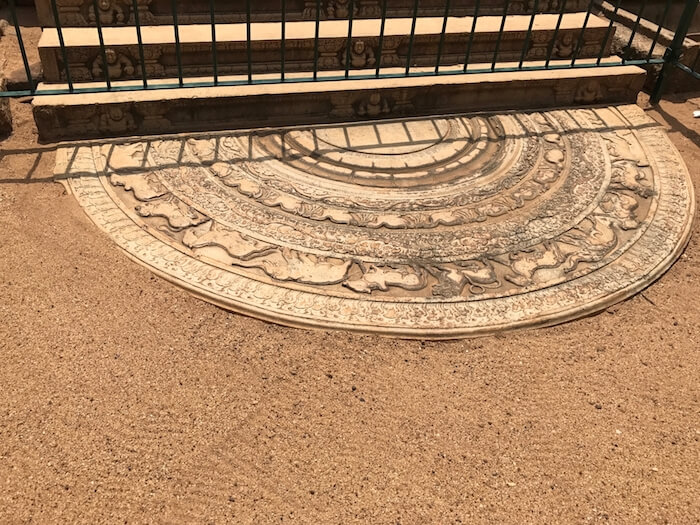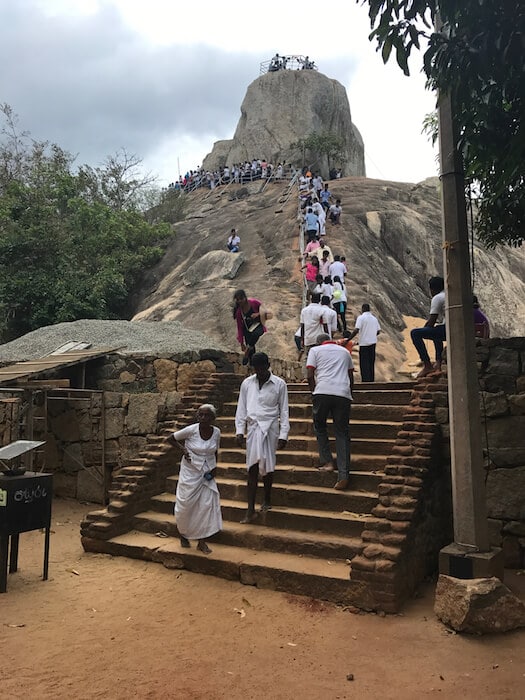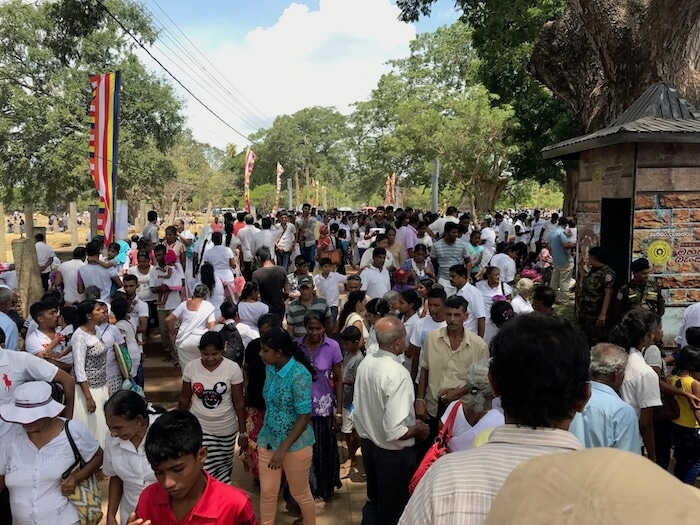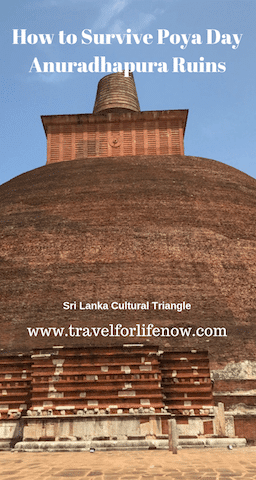Table of Contents
Sri Lanka-The Cultural Triangle
I had been trying to convince Reggie for many years to visit Sri Lanka. We were finally going. We love temples and historical sites so we wanted to learn about the ancient Anuradhapura Kingdom. Our trip started with several days in the Cultural Triangle at the Anuradhapura ruins in Sri Lanka.
The cultural triangle is in the center of the island and includes Anuradhapura, Polonnaruwa, Sigiriya, Dambulla and Kandy/the Temple of the Sacred Tooth Relic. They are all UNESCO World Heritage Sites and we planned on seeing them all.
We arrived in Colombo and spent the night. Unfortunately, we didn’t have much time to see the many places to visit in Colombo before setting off for the Cultural Triangle.
Anuradhapura Kingdom
The Anuradhapura was the capital of the Anuradhapura Kingdom and was established in Sri Lanka in 377 B.C. This was the period that Buddhism was brought to Sri Lanka and influenced the culture and politics of the region. In 1017, the Cholas from Southern India invaded and conquered Anuradhapura, ending the Anuradhapura Kingdom. After that, the capital was moved to Polonnaruwa.
In ancient times, Anuradhapura had extensive palaces and dagobas (also called stupas) that were 9 stories high. The main street was 16 miles long. There were numerous palaces and mansions. The Anuradhapura sites are spread out over a large area.
Key Sites to See in Anuradhapura
The key sites to see in Anuradhapura are the:
Sacred Bodhi Tree
The Bodhi Tree is said to have grown from a cutting from the sacred tree in India that the Buddha attained enlightenment under.
Abhahagiri Vihara Monastery and Moonstones

Abhahagiri Vihara Moonstone
Founded in the 2nd century BC, Abhahagiri Vihara was the most important monastery in ancient Sri Lanka and the Anuradhapura kingdom. It remains one of the most sacred pilgrimage sites to this day. It was a seat of learning for all schools of Buddhist thought. The Moonstones are exquisite and were are the entrances to buildings.
Ruwanwelisaya Stupa
Ruwanwelisaya Stupa was built by King Dutugemunu and completed in 140 BC. It is also known as the white Stupa and stands at 330 feet tall with a circumference of 950 feet.
Jethawanaramaya Stupa
Jethawanaramaya Stupa was built by King Mahasena between 273-301 AD. When it was built it was said to be the tallest stupa in the ancient world with a height of 400 feet.
Mihintale
Mihintale was our last stop and involves many, many steps. It is a short drive from the other sites in Anuradhapura. There are many steps carved into the mountain that allow pilgrims to climb up to the top of the stupa. We started the climb–but it was so crowded it would have taken too long to get to the top. Hundreds of thousands of feet have worn down the steps and they are a little scary. There is a fence to hold onto for part of the climb.

The top of Minhintale
Anuradhapura on Poya Day
We only had one day for Anuradhapura so were hoping to see as much as possible. As we got closer, the traffic started to get heavy. We saw hundreds of families in all manner of transport. Some walking. Others on three-wheelers. Some on motorcycles and bikes. From the very elderly to infants in their parent’s arms, every age was represented. Many were dressed in all white and often barefoot.
We asked Champika, our driver and guide, what was happening. He told us that it was Poya Day. Poya Day in Sri Lanka happens once a month in the morning after a full moon. Everyone goes to pray on Poya Day. And, we mean EVERYONE. It seemed like the entire country was going to the same place as us. Sri Lanka is 70% Buddhist and many businesses are closed on Poya Day.
Sri Lankan Families at Poya Day
Families arrive early in the morning and most don’t leave until dusk. Along the path to the Temple, there were tents with free food for the devotees and pilgrims. Many families were eating, sleeping and generally resting in between their pilgrimages to the dagobas.
Visitors to these sacred grounds must remove hats and footwear. Many people arrived barefoot. Other people left their sandals and flip flops on the ground at the entrances.
Devotees carry a bunch of fragrant flowers as offerings to their gods. They walk around the stupas several times praying.
There were booths for leaving your shoes for safekeeping for a small fee and we elected to use them. It was 90 degrees and our feet weren’t ready for the hot stones.
Sri Maha Bodhi Tree
The site of the Sri Maha Bodhi tree was very crowded. This sacred tree grew from a cutting brought from Bodhgaya in India. High security surrounds the sacred oldest tree in the Sri Lankan Buddhist world. People offered up robes & bowls for the monks in exchange for blessings.
In order to see the full site, you need several days. We had only one. And, a crowded one at that. But, we had the chance to experience Poya Day.
How to Survive Poya Day at Anuradhapura Ruins Sri Lanka

We saw Poya as a privilege to experience. It is a very important day for Sri Lankans and we were there with them. Some tips for experiencing Poya Day:
- Let your self experience the history and spirituality of the Sri Lankans. Let it influence how you are at the sites.
- Be respectful. The crowds are not in your way. You are taking part in a centuries-old tradition.
- Don’t expect to see everything you thought you would see. You are having a different experience and actually seeing more than what you thought you would.
- You will be taking your hat and shoes off everywhere you go. Wear shoes or sandals that are easy to slip on and off.
- The ground is hot. Very hot. You are likely not used to it. We walked barefoot and by the end of the day, our feet were very sore. We did see some tourists wearing socks.
- Drink a lot of water. Wear sunscreen. Bring a hat even though you’ll be removing it a lot.
Mostly, let yourself enjoy the experience of traveling and getting to know the people and a country.
Don’t miss spending time in Colombo either at the beginning or end of your trip. Here are some great things to do in Colombo.
For some of our other Sri Lanka Adventures, check out:
Ouch Ouch Visiting Temples in Sri Lanka
Cows, Cars and Elephants Oh My: Driving in Sri Lanka
Please Pin and Share




Great! SL is my next target. Thanks for thoughts and ideas. Feel free to visit my site
Looks like some awesome ruins! Really love the Ruwanwelisaya Dagoba. A bit crowded though…. I guess that’s Sri Lanka for you.
There’s so much to do! I may need to add this to my list. Although, I have a feeling I’d be one of those tourists in socks, because I’d wimp out walking around on the hot ground all day. 🙂
Well, our feet really hurt by the end, so socks is not so bad an idea. I might suggest wearing sandals and just putting on the socks for walking, then taking them off. If you wear socks and then put your feet into your shoes, you’ll get tons of sand and pebbles in your sneakers.
Looks incredible! Just like you, I’ve been dreaming of Sri Lanka for many years and trying to convince my partner that it’s a good idea! I’ll definitely be forwarding him this 🙂
It was worth the wait. We both enjoyed the trip. We are going to be doing a full itinerary post soon so stay tuned for that.
It must’ve been lovely to experience this – from my reading I remember that there is a Bodhi Tree in India as well. It must’ve been a great experience to be there for the festival as well. The stupa looks incredible!
Thanks. It was a great experience. The Bodhi trees are related. The one in Sri Lanka was supposed to have been grown from a cutting brought from India.
We’ve not been, although looking for a bucket list destination for our wedding anniversary. May be this could be it. Thank you. Kx
I know several people who’ve done their honeymoon there
I’ve never been to Sri Lanka, but I do love temples. I’ve attended Buddhist celebrations in other countries, and I would like to experience Poya Day. I am assuming the date changes every year. I’ll have to check the date for next year.
Nancy,
Poya day is every month and usually the day after the full moon. It’s announced by the government so it can change but you might be able to plan a few days on and after the full moon to catch Poya Day.
What a privilege and an amazing experience. Sri Lanka is definitely on my radar and I’ll be adding Anuradhapura Ruins to the list of must-dos!
Thank you. I definitely recommend Anuradhapura and the whole cultural triangle. Save enough time to go slow.
This is such a beautiful, yet busy place, Thank you very much for your useful advices. I would love to visit one day 🙂
Thanks and I hope you get there someday
We visited Sri Lanka for a month a couple of years back, loved it! Loved the food too…perhaps a bit too much ? Great article, brought back some nice memories.